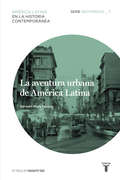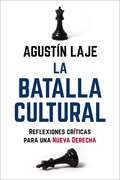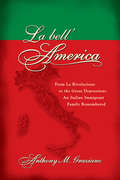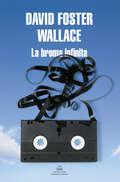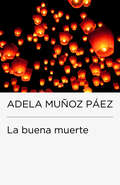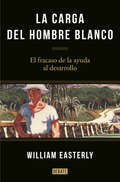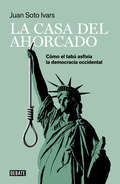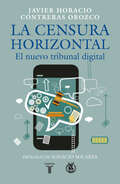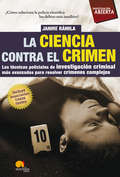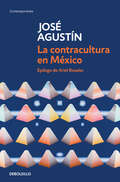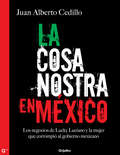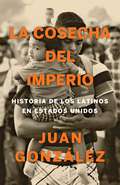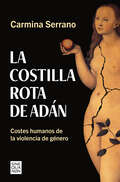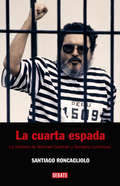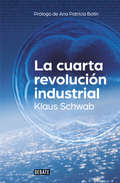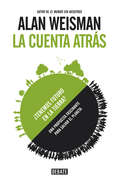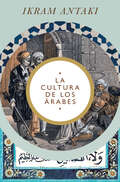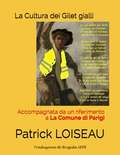- Table View
- List View
La Valeur d'Une Femme
by G. G. Vega Elphanielle HervéMalheureusement, l’histoire de l’humanité après le déluge (Genèse 6 y 7), nous a montré que les femmes ont beaucoup souffert, surtout de l’abus des hommes, un manque de respect et un manque de valorisation de l’identité de la femme. Elles ont souffert de ridicules limitation sociales, intellectuelles et du travail, un manque de considération de tout type, mépris, discrimination et marginalisation. À un moment, les hommes ont commis l’injustice de les appeler le sexe faible, en général, dans le sens du mépris, d’inutilité ou d’une gêne. Ce qui est ironique c’est que chaque homme, après Adam, existe grâce à une femme. Sans le ventre de la femme, ils ne pourraient pas être enfanté, sans la poitrine de la femme, ils ne vivraient pas plus d’une semaine, et sans la protection, l’aide, l’attention et l’éducation de leurs mères, ils ne deviendraient pas des hommes utiles, ils ne pourraient pas être forts, ni se sentir capable de prendre son indépendance. Ce livre a le but de mettre en avant ce que mérite les femmes. Nous, les hommes, ne sommes pas plus, nous avons seulement un autre rôle dans la vie.
La Verità dietro il Covid-19 Anteprima
by Mack C. MooreLa Cina ha approvato la legge sul vaccino prima della pandemia? Esistono report accurati sul Covid-19? I vaccini sono sicuri? È davvero il COVID la reale minaccia? Trova le risposte a queste domande e tanto altro ancora in La Verità dietro il Covid-19 Anteprima. Questo libro analizza i report riguardanti la pandemia e fuga i timori e le preoccupazioni che abbiamo per il COVID. Svela la verità dietro la pandemia di COVID-19. Questa è un'anteprima di una versione più dettagliata ed esplosiva in uscita nel 2021. Scopri le verità che ci stanno nascondendo!
La aventura urbana de América Latina. Recorridos_3
by GERMÁN MEJÍA PAVONYEl ochenta por ciento de los latinoamericanos vive hoy en poblaciones de más de 20.000 habitantes. Esta cifra sorprende, pues aceptamos que la mayoría de las localidades de la región apenas sobrepasa el carácter rural. En realidad, la historia del desarrollo urbano del subcontinente ha sido desdeñada por teorías victimistas que la condenan sin remedio al atraso; por ello, resulta paradójico que desde los primeros años del siglo XIX la ciudad se revelara esencial para la construcción de los nuevos Estados nacionales, y que la producción de riquezas, de origen agrario o minero, encontrara en sus urbes la única posibilidad para transformar la sociedad entera. La historia de América Latina es, en este sentido, una aventura de futuro que se construye desde las entrañas de su ya longeva dinámica urbana. Recorridos se propone destacar los ejes comunes a la historia de América Latina en una perspectiva global, libre de visiones nostálgicas y exóticas. La serie analiza desde la independencia hasta la actualidad temas y horizontes que trascienden lo nacional, tanto en el espacio como en el tiempo. Mediante una narrativa accesible y con un enfoque novedoso, identifica elementos de originalidad social y cultural. También reflexiona sobre la potencia y la presencia de América Latina en tiempos de globalización, en los que se ha convertido en destacada protagonista.
La batalla cultural: Reflexiones críticas para una Nueva Derecha
by Agustin LajeEl afamado escritor, politólogo, y conferencista Agustín Laje presenta La batalla cultural: Reflexiones críticas para una Nueva Derecha – un manifiesto que informará, animará y facultará a los &“guerrilleros culturales&” para no bajar los brazos en la batalla que sigue perjudicando a nuestras familias y a la sociedad en general.En el mundo contemporáneo, la sociedad y la cultura cambian a gran velocidad. La voluntad de dirigir esos cambios está en la base de las batallas culturales que hoy se viven en todas partes. Bien investigado y argumentado inteligentemente, este libro define el concepto de batalla cultural y muestra hasta qué punto la cultura ha llegado a ser el botín principal del poder, cómo se han desarrollado estas batallas desde los tiempos modernos hasta la actual posmodernidad y cómo enfrentarlas.En este libro, Agustín Laje:Explica qué es la batalla cultural, cómo darla, y cuales son su característicasAnaliza cómo la nueva izquierda entendió este fenómeno, frente a una derecha que menospreció el poder de la culturaExamina cómo entendió este fenómeno la nueva izquierda, frente a una derecha que menospreció el poder de la culturaPretende brindar las herramientas necesarias para el nacimiento de una nueva derechaEste libro está dirigido a: Las familias que son el principal blanco de ataque en este momento, que se sienten fragmentadas, amedrentadas y que quieren hacer algo más para convertirse en agentes de batalla culturalA los Jóvenes que cursan sus estudios y que entienden que en sus universidades cada vez hay menos educación y más adoctrinamientoA todo aquel que se preocupa por los asuntos políticos y mundiales de gran magnitud que crean conflictos en la sociedad&“La lucha política y la lucha cultural son las dos caras de una misma moneda. Si no hay política sin hegemonía, entonces tampoco hay política sin batalla cultural&”, dice Laje. &“La batalla cultural terminará mostrándose como la madre de todas las batallas.&”The Culture BattleFamed writer, political scientist, and lecturer Agustín Laje presents The Culture Battle: Critical Reflections for a New Right – a manifesto that will inform, encourage and empower the &“cultural guerrillas&” not to give up in the battle that continues to harm our families and society in general.In the contemporary world, society and culture are changing at great speed. The will to lead these changes is at the basis of the cultural battles that are being fought everywhere today. Well researched and intelligently argued, this book defines the concept of cultural battle and shows to what extent culture has become the main spoils of power, how these battles have developed from modern times to today's postmodernity and how to face them.In this book, Agustín Laje:Explains what the culture battle is, how to wage it, and what its characteristics areAnalyzes how the new left understood this phenomenon, in the face of a right wing that underestimated the power of cultureExamines how the new left understood this phenomenon, in the face of a right wing that underestimated the power of cultureAims to provide the necessary tools for the birth of a new right wing
La bell'America
by Anthony M. Graziano"This is a delightful, passionate and memorable rendition of a familiar and glorious tale. As the son of immigrants who were very much like Anthony Graziano's family, I was especially moved. Thank you for telling our story."-Governor Mario M. Cuomo"This kind of historical data is rare today. . . . A tapestry of history, biography, personal reminiscence, and lessons."-Michael Giallombardo, director/producer of La Terra Promessa"A sweeping narrative of European and American history, and a lovingly crafted reminiscence. Graziano is an excellent storyteller. There is something in this book for everyone, not least of which is a very good read."-Joan M. Crouse, author of The Homeless Transient in the Great Depression"Writing in the tradition of C. Wright Mills, who defined [sociology] as the intersection between history and biography . . . this book clarifies the tremendous emigration from Italy. A very enjoyable read, suitable for general readers and students of history and sociology."-Adeline Levine, author of Love Canal: Science, Politics, and PeopleA picture of Europe's nineteenth century and the massive Italian immigration to America: wars and conflicts, popes and kings fighting the people's demands for democratic government. When religion and royalty failed them, leaders created dictatorships and threw the world into bloody conflicts, killing hundreds of millions and virtually destroying Europe. Caught up were the poverty stricken, powerless common people who became the immigrants, pushed from Europe, pulled to America. Their history comes alive in the author's deeply personal account of his family's immigration and survival through the Great Depression.Anthony M. Graziano, SUNY Buffalo professor emeritus and Italian chef, has written fifteen books and fifty articles in the field of psychology. His brother, parents, and extended family emigrated from Italy. He says, "This book is a celebration of immigrants. It speaks to us because we are all immigrants."
La broma infinita
by David Foster WallaceUna novela crítica, divertida y reflexiva sobre la adicción, el consumismo y la soledad de la sociedad norteamericana, escrita con gran sabiduría y sentido del humor. Un lugar: Enfield, Massachusetts. A cien millas de la Gran Concavidad, un yermo radiactivo lleno de bebés mutantes del tamaño de aviones, criaturas sin cráneo y hordas de hámsters salvajes. Una época: el año de la Ropa Interior para Adultos Depend, en el Tiempo Subsidiado, en una América regida por el totalitarismo ecológico de la ONAN, gobernada a su vez por la oscura Oficina de Servicios No Especificados, en guerra perpetua contra el ultraviolento antiONANismo de Quebec. Una institución: la Academia Enfield de Tenis, ultraelitista y donde impera una disciplina destinada a abolir todo placer. Una familia: los Incandenza. James Incandenza, óptico militar convertido en cineasta de après-garde, y su mujer, la promiscua Avril, que alimenta oscuras conexiones con la guerrilla de Quebec. Y sus tres hijos: Orin, genial pateador de fútbol americano y seductor transnacional; Mario, enano y deforme, cineasta como su padre y poseedor de una sensibilidad prodigiosa, y Hal, promesa del tenis juvenil y atormentado por un secreto terrible. Y una película: El samizdat. El Entretenimiento. La broma infinita. Con el poder de enloquecer a todo el que la vea y destruir así la civilización. El arma perfecta por la que todos se enzarzarán en la Guerra Final por el control de América. Reseñas:«Colosamente disruptiva... espectacularmente buena.»Walter Kirn, The New York Magazine «Después de veinte años La broma infinita sigue siendo hoy un reto, sigue siendo brillante.»The Guardian «Todavía se siente tan trascendente, eléctricamente viva.»The New York Times «Wallace, cuando recurre a la erudición, cuando disecciona toda la cultura pop de nuestra época es magistral.»El Mundo «Es una obra inteligente, difícil, brillante y, no lo duden, vale la pena llegar hasta el final. Como afirmó el crítico Sven Birkerts, quienes lo hagan tendrán el raro privilegio de contemplar el universo iluminado por un torrente de luz negra.»Eduardo Lago, El País
La buena muerte (Colección Endebate #Volumen)
by Adela Muñoz PáezUna reflexión necesaria sobre la eutanasia, y las implicaciones morales y legales de luchar por una muerte digna. La muerte sigue siendo un tema tabú en las sociedades occidentales, una cuestión que entendemos que está fuera de nuestras manos y que, en opinión de muchos, queda en manos de Dios. En consecuencia, la eutanasia, el derecho de cada uno a decidir sobre su propia muerte, es uno de los debates más controvertidos pero también más necesarios de nuestros días. Adela Muñoz Páez expone casos reales y explica cuáles son las implicaciones científicas morales y legales de la eutanasia, en un texto que nos ayuda a reflexionar sobre el derecho a tomar nuestra última decisión.
La cara oculta de Eva: La mujer en los países árabes
by Nawal El Saadawi«La cara oculta de Eva», un clásico de la literatura árabe moderna, denuncia la opresión que sufren las mujeres en el mundo islámico y, con unos nuevos prólogo y epílogo, mantiene toda su vigencia más de veinticinco años después de su publicación. Nawal El Saadawi relata de manera impactante la violencia y la injusticia que se han extendido por la sociedad en la que vive. Su experiencia como médico rural en distintas zonas de Egipto, como testigo de la prostitución, de los asesinatos por razones de honor y de los abusos sexuales, además de la ablación, que ella misma sufrió de niña, la impulsaron a dar testimonio de todo este sufrimiento. Con claridad y precisión detecta y analiza las causas de esta situación, y describe el papel histórico de la mujer árabe en la religión y la literatura. Para la autora, el velo, la poligamia y la falta de igualdad ante la ley de hombres y mujeres son incompatibles con el islam y con cualquiera de las otras religiones.
La carga del hombre blanco: El fracaso de la ayuda al desarrollo
by William EasterlyWilliam Easterly, uno de los economistas especializados en desarrollo más importantes del mundo, fue despedido del Banco Mundial por criticar la incompetencia flagrante de las organizaciones occidentales a la hora de mitigar la pobreza global.Este libro es su respuesta. La carga del hombre blanco es una crítica feroz a los arrogantes esfuerzos y a las ineficaces políticas económicas de Occidente por mejorar el destino de los supuestos países en desarrollo. En ocasiones irreverente, en otras airado, pero siempre clarividente y riguroso, Easterly plantea que Occidente debe afrontar su propia historia de ineptitud y sacar sus propias conclusiones, especialmente cuando la cuestión de nuestra capacidad de trasladar las instituciones occidentales al Tercer Mundo es uno de los debates más acuciantes a los que nos enfrentamos. Un libro de denuncia que ofrece propuestas realistas para reducir la desigualdad en el mundo. Reseña:«La carga del hombre blanco es un valiente y documentado texto que denuncia el fracaso de la ayuda al desarrollo.»Bernabé Sarabia, El Cultural
La casa del ahorcado: Cómo el tabú asfixia la democracia occidental
by Juan Soto IvarsUn original ensayo sobre el tabú y su relación con las nuevas formas de censura contemporáneas. ¿Cómo podemos defender el pensamiento individual ante el exceso de líneas rojas? Los proyectos comunes que han sostenido las sociedades democráticas occidentales parecen rotos. Ni siquiera una pandemia global logra hacernos comprender que los grandes retos requieren respuestas colectivas. Sometidos a las reglas del identitarismo, una polarización extrema ha dado lugar al narcisismo tribal y al ensimismamiento autorreferencial. Colectivos erotizados por su propia identidad y hostiles al resto, victimistas profesionales y nacionalistas excluyentes dominan un panorama donde parece justificable eliminar los derechos de las personas en pos de una causa mayor. La casa del ahorcado es un demoledor y controvertido ensayo que observa los efectos de la cultura del sentimentalismo en la libertad de expresión y analiza algunas de las manifestaciones más alarmantes de nuestro retroceso hacia la tribu. Con mirada antropológica, pero sin intención académica, Soto Ivars nos ofrece un recorrido por diversos casos contemporáneos de retorno al tabú, el horror sacro, el chivo expiatorio, la herejía y el castigo ritual, y propone la restauración del concepto de ciudadanía como única salida a la guerra civil de las identidades. «Comparto con las almas puras la idea de que nadie con un mínimo de sensibilidad mencionaría la soga en la casa del ahorcado, pero como veremos en las próximas páginas, nos enfrentamos a un problema enorme: en un mundo global e hipercomunicado la casa del ahorcado no tiene paredes, ni puerta por la que escapar, abarca el mundo entero sin dejar un resquicio para la libertad.»
La caída del telepresidente: De la imposición de las reformas a la indignación social
by Jenaro VillamilAuge y declive del peñismo: el gran montaje sucumbió y se transformó en una profunda crisis. En este libro Jenaro Villamil describe puntualmente cómo sobrevino ese proceso de decadencia. Jenaro Villamil describe puntualmente cómo sobrevino la decadencia del llamado Mexican Moment, así como las acciones del régimen peñista a partir de esa crisis. Con prólogo de Elena Poniatowska. Auge y declive del peñismo: el gran montaje sucumbió y se transformó en una profunda crisis. En este libro Jenaro Villamil describe puntualmente cómo sobrevino ese proceso de decadencia. El llamado Mexican moment, sobrevendido con la promesa de magnas reformas estructurales, pronto se evidenció como una farsa, y los propios medios extranjeros que al principio alabaron al joven presidente comenzaron a descubrirla: se encontraron con un país de narcofosas, de miles de desaparecidos, con la historia trágica de los 43 estudiantes de Ayotzinapa, con una reforma energética que resultó inoperante ante la baja de los precios del petróleo y con la corrupción nada disimulada del primer círculo de colaboradores del ejecutivo. Ante la caída, Peña Nieto ha optado por volverse un caudillo arcaico; busca el efectismo mediático sin principios ni hoja de ruta, convirtiendo así el cinismo en el disfraz del fracaso. No obstante, subraya el autor, la ambición de una presidencia imperial no dejará de estrellarse durante los próximos años con una fuerte y crítica resistencia social. Extracto del prólogo "Jenaro Villamil analiza no sólo la personalidad de Enrique Peña Nieto, también examina su proyecto de nación -que a los ojos de sus opositores es inexistente-, critica las reformas estructurales con las que el priísta intentó transformar al país y muestra cómo su gobierno está en franca decadencia a causa de la ineptitud para solucionar los conflictos económicos, sociales y de seguridad. Los pobres son más pobres, los niveles de violencia e inseguridad se dispararon y el presidente encopetado se quedó impávido. A EPN el cargo le ha quedado grande." Elena Poniatowska
La censura horizontal: Un nuevo tribunal digital
by Javier Horacio Contreras Orozco«Javier Contreras ha escrito un libro excepcional y necesario en estos tiempos de tecnologización de la vida pública.» Ignacio Solares Hoy en día las redes sociales son mucho más que simples herramientas de entretenimiento, información y socialización: una parte de nuestras vidas transcurre dentro de ellas. Han ampliado nuestra capacidad de comunicación de forma inaudita, le han dado voz a personas que antes no la tenían y, sobre todo, permiten que la información fluya con una velocidad y en volúmenes sorprendentes. Sin embargo, estas características no han hecho de las redes sociales los espacios de diálogo y tolerancia que esperábamos de ellas. Por el contrario, con frecuencia las hemos visto convertirse en la gran hoguera del siglo xxi. En este libro, Javier Horacio Contreras Orozco analiza las condiciones y procesos que han llevado a las redes sociales a constituirse en un jurado universal que ejerce un nuevo tipo de censura: la poscensura o censura horizontal. A diferencia de la censura tradicional, que provenía de los gobiernos o de poderosos intereses privados, la censura horizontal es un sistema de vigilancia y silenciamiento entre pares. Un tribunal sin juez o, mejor dicho, en el que todos son jueces, pero en el que también todos pueden ocupar el banquillo de los acusados de un momento a otro. Al excluir a una gran cantidad de voces del debate público, la censura horizontal contribuye a la pandemia de desinformación que caracteriza nuestros días. Es uno más, como advierte Contreras Orozco, de los síntomas de la era de la posverdad.
La ciencia contra el crimen (Investigación Abierta)
by Nuria Janire RámilaEste libro cuenta la historia de las técnicas criminalísticas más curiosas e importantes aplicadas para la resolución de crímenes complejos como, por ejemplo, la entomología forense, la perfilación criminal, el uso del luminol, la antropología forense… Además, explica cómo son utilizadas estas técnicas y se desarrolla un caso histórico real en el que cada una jugó un papel decisivo. Cabe destacar que, aparte de las referencias bibliográficas, para la documentación de esta obra, la autora utiliza informes de autopsias, extractos periodísticos, sentencias judiciales, estudios de profesionales de la salud mental, reglamentos policiales y reglamentos de actuación del FBI. Entre los casos comentados se encuentra el del célebre asesino múltiple de Río Verde apresado gracias al estudio de un insecto. También se verá cómo el luminol demostró que en la habitación de un hotel se había producido un asesinato aunque no hubiera una sola mancha de sangre a simple vista. Este libro logra aproximar al lector a las técnicas criminalísticas popularizadas por distintas series de televisión y permite, a su vez, conocerlas para descubrir cómo son utilizadas en realidad y cuáles son sus límites durante una investigación.
La coartada perpetua
by Ambrosio FornetUna de las figuras más destacadas de la crítica literaria y cinematográfica cubana reúne en este libro sus mejores ensayos. Preocupado por los problemas que relacionan la historia moderna de Cuba con sus intelectuales, Ambrosio Fornet ha desplegado en sus textos un talento excepcional para definir las líneas del peculiar desarrollo de la cultura cubana a partir de la guerra hispano-cubano-americana de 1898 y de la independencia mediatizada, a la que dio lugar después de tres años de ocupación norteamericana. Tal es el asunto del primero y cuarto ensayos de esta colección. La revolución de 1959 que rompió este proceso neocolonial, inició una ambiciosa experiencia socialista que encontró hasta hoy, en Estados Unidos, un enemigo decidido a destruirla. ¿Cómo esa revolución ha podido, durante más de cuarenta años, resistir ese amenazador enfrentamiento sin abandonar sus propósitos de liberación y justicia social? El segundo ensayo de este libro brinda el "testimonio personal" de Ambrosio Fornet que responde a ese "enigma cubano". El exilio que las medidas revolucionarias cubanas provocaron desde muy pronto y que Estados Unidos propició de manera constante, determinaron la aparición en Estados Unidos de una literatura cubana del exilio que se ha manifestado y se manifiesta tanto en español como en inglés. Los méritos de esta creación literaria exiliada y los conflictos provocados por el bilingüismo han sido un tema en el que Fornet se ha explayado con notable objetividad y brillantez según puede verse en el tercero y sexto ensayos de la colección. El más extenso de todos ellos es una interesantísima "arqueología del nuevo cine latinoamericano (1959-1979)" que hace un balance crítico importante de esa crucial etapa del cine en nuestro subcontinente. Por ultimo, el libro se cierra con un ensayo medular sobre el "testimonio" en cuanto género literario peculiar de América Latina.
La contracultura en México (Edición de aniversario): La historia y el significado de los rebeldes sin causa, los jipitecas, los punks
by José AgustínUna audaz radiografía sobre los movimientos contraculturales en México en voz de uno de sus mayores exponentes. "190 páginas llenas de salvajes historias de rebeldía, ingenuidad, incorrección, desmadre, lucidez, arte, literatura, drogas, punks, darketos, jipitecas, cholos, chavos banda, sexo y rockanroll. Pero sobre todo, [este libro] reivindica la dignidad de no estar de acuerdo con "el poder" y la vigencia de esa entelequia que se llama 'contracultura'" -Carlos Martínez Rentería, fragmento del prólogo- La contracultura en México se desplaza entre varios géneros, cubriendo los grandes movimientos y las manifestaciones contraculturales más importantes que ha tenido nuestro país, tales como los pachucos, los existencialistas, las pandillas juveniles o el rockanroll. En esta obra alucinante, el autor también da cuenta de las expresiones juveniles que han incidido en la música, la literatura, el teatro, el cine, la gráfica, la televisión y las publicaciones. El lector hallará excelentes herramientas para analizar la realidad, así como datos indispensables para leer y comprender los tiempos y las manifestaciones que han enfrentado a la cultura predominante. Otros autores han opinado: "Fue el primer escritor que incorporó recursos de la cultura de masas y contracultura a la literatura mexicana: las onomatopeyas de los cómics, el montaje cinematográfico, las acotaciones teatrales y el mundo interior de la psicodelia" -Juan Villoro- "Cuando un escritor logra identificarse con los jóvenes de cualquier época, trasciende el momento en el que escribió su obra, porque la juventud tiene más o menos las mismas características. Ése es el secreto de que las novelas de Agustín hayan sobrevivido y sigan siendo leídas por los jóvenes en la actualidad" -Enrique Serna- Fragmento del epílogo: "No sé bien si en estas páginas encontrarán las respuestas que buscan [...] pero de lo que estoy seguro es que además de informarse de lo que sucedió con el rock, los jipitecas, los alucinógenos y todo lo subsecuente, van a gozar esta crónica escrita a través de una prosa rodante y antisolemne que no ha perdido un ápice de su frescura original" -Ariel Rosales-
La cosa nostra en México (1938-1950): Los negocios de Lucky Luciano y la mujer que corrompió al gobierno mexicano
by Juan Alberto CedilloEl mejor libro jamás escrito sobre la mafia siciliana desde sus orígenes hasta nuestros días que desvela las tramas ocultas y el funcionamiento de esta organización criminal. Una reveladora investigación histórica que documenta cómo se infiltró la mafia italiana en el gobierno mexicano, durante los años cuarenta. Un antecedente directo de los cárteles de la droga. En La Cosa Nostra en México, Juan Alberto Cedillo, autor del bestseller Los nazis en México, narra la historia de una camarera que se convirtió en la mujer más poderosa de la mafia y corrompió al gobierno mexicano: Virginia Hill. Esta hermosa e inteligente pelirroja comenzó a trabajar a los 17 años para aquella organización criminal, en 1933. Fue apostadora profesional, experta en lavado de dinero y mensajera de los capos. Conoció al poderoso gángster Benjamin Bugsy Siegel, con quien se casó. Ella lo ayudó a establecer las conexiones necesarias para traficar marihuana, opio yheroína desde México hacia los Estados Unidos. Tras el sangriento asesinato de Siegel en 1947, la plana mayor de la mafia, Lucky Luciano, Frank Costello y Meyer Lansky, la envió de nuevo a México con una misión: comprar funcionarios mexicanos del más alto nivel, con el propósito de establecer un casino en el puerto de Acapulco y asegurar su naciente industria de narcotráfico. Entre suntuosas fiestas a las que acudían importantes personajes del gobierno, hermosas mujeres y miembros de la mafia, numerosos servidores públicos fueron seducidos por el dinero y el lujo La Cosa Nostra en México es un espléndido retrato de época con revelaciones inéditas sobre los lazos entre el poder y la mafia, donde todos los hombres pueden ser comprados, con dólares o con mujeres.
La cosecha del imperio / Harvest of Empire: Historia de los latinos en Estados Unidos
by Juan GonzalezUna historia arrolladora, cuidadosamente revisada y actualizada, de la experiencia latina en Estados Unidos. Es la primera reedición en diez años de este importante estudio sobre los latinos en la historia de Estados Unidos. La cosecha del imperio cubre un periodo de cinco siglos, desde las primeras colonias en el Nuevo Mundo, hasta la primera década del nuevo milenio. Hoy en día, los latinos representan el grupo minoritario más grande en Estados Unidos, y su impacto en la cultura popular del país —desde la comida, hasta el entretenimiento y la literatura— es más profundo que nunca. Con retratos de familia de pioneros latinos migrantes, así como recuentos de los eventos y condiciones que los llevaron a dejar sus patrias, La cosecha del imperio es una lectura obligada para cualquiera que desee comprender la historia y el legado de este grupo, cuya influencia va en aumento. Juan González, columnista del New York Daily News, ha vivido en Estados Unidos cincuenta de sus cincuenta y un años. Sus numerosos reconocimientos incluyen el Premio George Polk en 1998 por la excelencia en el periodismo, y el premio a su trayectoria de parte de la Academia Hispánica de Artes Mediáticas y Ciencias. Nacido en Puerto Rico, creció en un barrio de multifamiliares y fue cofundador del partido Young Lords en los años sesenta. Vive en la Ciudad de Nueva York.
La costilla rota de Adán: Costes humanos de la violencia de género
by Carmina SerranoUn ensayo único y necesario sobre los costes psicológicos de la violencia de género, el trauma y su recuperación. A pesar de los grandes logros en igualdad de las últimas décadas, la violencia de género es una realidad todavía omnipresente. En el último año, 243 millones de mujeres y niñas de todo el mundo han sufrido violencia sexual, física o psicológica. En España, cada tres días una mujer es asesinada por su pareja. La costilla rota de Adán está dirigido a las mujeres que sufren las consecuencias traumáticas y los efectos devastadores de este tipo de violencia naturalizada, ejercida mayoritariamente de forma silenciosa y psicológica. Desde el conocimiento otorgado por su larga trayectoria en experiencia clínica, la autora nos brinda, entre otros aspectos, las claves sociales para comprender las causas de este fenómeno, nos explica cómo se ha diagnosticado el sufrimiento de las mujeres a lo largo de la historia, identifica las múltiples formas ocultas en las que se ejerce, así como las maneras en las que se interioriza y se expande a las relaciones afectivas y sexuales, y finalmente nos proporciona las herramientas psicoterapéuticas para la recuperación de las víctimas. «Me gustaría muchísimo que este libro pudiera servir para realizar un viaje emocional y cognitivo que permita comprender el complejo mundo de la violencia de género y sus efectos devastadores sobre la humanidad... Que se consiguiera percibir en qué medida los roles de género que instituyó el patriarcado han sido y siguen siendo generadores de desigualdad, deshumanización, enfermedad y trauma».
La cuarta espada: La historia de Abimael Guzmán y Sendero Luminoso
by Santiago RoncaglioloLa cuarta espada es una rigurosa investigación periodística sobre Sendero Luminoso y su líder, Abimael Guzmán. Casi 70.000 muertos produjo la guerra entre el movimiento terrorista Sendero Luminoso y el Estado peruano entre los años ochenta y noventa. Responsable de más de la mitad de las víctimas, Sendero fue el grupo subversivo más letal en la historia del continente americano. Abimael Guzmán, el hombre que condujo toda esa violencia y se considera a sí mismo como la «cuarta espada» del comunismo internacional tras Lenin, Stalin y Mao, no llevaba armas. No tenía poyo de Gobiernos extranjeros. Ni siquiera estaba presente en el campo de batalla. Detrás de un escritorio, armado con una rigurosa ideología, puso en jaque a todo un país durante doce años. Su historia constituye un escalofriante ejemplo del poder destructor de las ideas. ¿Cómo se convirtió Guzmán en un objeto de culto capaz de inspirar entre los suyos misiones kamikazes? ¿Quiénes eran sus soldados? ¿Cómo eran el amor y el odio entre ellos? La cuarta espada es la primera descripción de las relaciones humanas en el interior de una cúpula terrorista Sendero Luminoso con información proporcionada por sus protagonistas. Pero más allá del documento periodístico, este libro se lee como una novela en la tradición de A sangre fría, una inmersión en la mente del asesino, un retrato del Mal.
La cuarta revolución industrial
by Klaus Schwab¿Qué es la cuarta revolución industrial? ¿Cómo definirá nuestro futuro? Un libro sobre el cambio de paradigma que vive nuestra sociedad actual por el fundador del Foro Davos. Son muchos los desafíos a los que se enfrenta el mundo hoy en día, pero posiblemente uno de los más importantes sea comprender la nueva revolución tecnológica que está acarreando la transformación de la humanidad debido a la convergencia de sistemas digitales, físicos y biológicos. Las nuevas tecnologías están cambiando la manera en la que vivimos, trabajamos y nos relacionamos los unos con los otros y la velocidad, amplitud y profundidad de esta revolución nos están obligando a repensar cómo los países se desarrollan, cómo las organizaciones generan valor e incluso lo que significa ser humanos. En La Cuarta Revolución Industrial, Klaus Schwab, fundador del Foro Económico Mundial, describe las características clave de la nueva revolución tecnológica y resalta las oportunidades y dilemas que ésta plantea. Las nuevas formas de colaboración y gobernabilidad, acompañadas de una narrativa positiva y compartida, pueden moldear la cuarta revolución industrial para beneficio de todos. Si aceptamos la responsabilidad colectiva de crear un futuro en el que la innovación y la tecnología sirvan a las personas, podremos llevar a la humanidad a nuevos niveles de conciencia moral.
La cuenta atrás: ¿Tenemos futuro en la tierra?
by Alan WeismanUna propuesta fascinante para salvar el planeta. La cuenta atrás es un libro audaz, inteligente y provocador, que nos explica cuáles son los efectos de nuestro desmesurado crecimiento demográfico y plantea la alternativa más rápida y razonable para restaurar el equilibrio. Una investigación de conclusiones revolucionarias que cambiará la manera en que vemos nuestras vidas y nuestro destino. El crecimiento de la población mundial se ha disparado hasta límites insostenibles: dado que cada cuatro días y medio nace un millón de personas más en un planeta finito, la población actual precisaría de los recursos de tres Tierras para alcanzar un nivel de vida semejante al de los países desarrollados, y con el sobrecalentamiento de la atmósfera y las alteraciones de los océanos, las perspectivas de un futuro sostenible para la humanidad son cada vez más dudosas. Weisman ha recorrido todo el planeta para hablar con personasque viven bajo sistemas políticos distintos, y para saber cómo viven y qué piensan gentes de distintas nacionalidades, culturas y religiones. Quiere conocer para poder dar respuesta a las preguntas que, según todos los expertos, son las más importantes y también las más difíciles de responder.
La cultura
by Dietrich SchwanitzÉste es un libro para aquellos que quieren tener una relación viva con su cultura. Muchas veces el conocimiento se ha visto encorsetado por fórmulas y barreras, y se ha alejado de su labor más útil, que es enriquecer nuestras vidas y ayudar a conocernos mejor. ¿Cómo y por qué surgieron la sociedad moderna, el Estado, la ciencia, la democracia o la administración? ¿Qué ha dicho Heidegger que no supiéramos ya? ¿Por qué Don Quijote, Hamlet, Fausto, Robinson, Falstaff o el Dr. Jekyll y Mr. Hyde son figuras tan conocidas? ¿Dónde estaba el inconsciente antes de Freud? Este libro aborda los episodios remotos y centrales del Antiguo y Nuevo Testamento; la emergencia de los Estados y la epopeya de la modernización, las revoluciones y la democracia; la evolución de la literatura, el arte y la música a través de sus grandes obras; el desarrollo de la ciencia y la filosofía, el campo de batalla de las ideologías, cosmogonías y teorías; pero también la educación que dan los libros, los colegios o universidades, los periódicos y los foros de opinión. Un cuadro cronológico, una breve relación de los libros que han cambiado el mundo y consejos de lectura aumentan la utilidad de esta obra imprescindible.
La cultura de los árabes
by Ikram AntakiCONOCE LA CULTURA DE LOS ÁRABES DE LA PLUMA DE IKRAM ANTAKI «El poeta Abul-Atahiya había grabado en el interior de su anillo: “Maldiga dios a la gente”. Y la gente que conoció eran aquellos árabes conquistadores y comerciantes que tradujeron la filosofía y la ciencia de los griegos, pero jamás dieron a conocer su propia literatura, que observaron el mundo y se olvidaron del cuerpo, que ejercieron hasta el cansancio su mente y desconocieron su alma. Quise hablar de estos árabes cuerdos y necios, derechos y torcidos, que he conocido a través de la vida compartida, de las leyes, de la literatura, del arte, de la filosofía, de la economía...
La cultura dei gilet gialli
by Patrick LoiseauIl movimento dei gilet gialli risuona il 17 novembre 2018 come un’insurrezione pregna di tutte le promesse democratiche: per finire con Macron, con le sue “riforme”, forse anche con le istituzioni bonapartiste della Quinta Repubblica. Sette mesi più tardi, incapace di strutturarsi, perso sulle pendici illusorie delle elezioni europee e poi del discorso “municipalista”, il crollo era totale. I gilet gialli sono sempre presenti ma hanno dovuto ritirarsi per un po’, con la promessa di ritornare…
La cultura: Todo lo que hay que saber (Ensayo (punto De Lectura) Ser.)
by Dietrich SchwanitzLa gran biblia cultural. Ésta es una obra para aquellos que quieren tener una relación viva con el saber, sin fórmulas ni barreras. Para los que piensan que la labor más útil de la cultura es enriquecer nuestras vidas y ayudar a conocernos mejor. <P><P>Éste es un libro para aquéllos que quieren tener una relación viva con su cultura. Muchas veces el conocimiento se ha visto encorsetado por fórmulas y barreras, y se ha alejado de su labor más útil, que es enriquecer nuestras vidas y ayudar a conocernos mejor. <P>¿Cómo y por qué surgieron la sociedad moderna, el Estado, la ciencia, la democracia o la administración? ¿Qué ha dicho Heidegger que no supiéramos ya? ¿Por qué Don Quijote, Hamlet, Fausto, Robinson, Falstaff o el Dr. Jekyll y Mr. Hyde son figuras tan conocidas? ¿Dónde estaba el inconsciente antes de Freud? <P>Este libro aborda los episodios remotos y centrales del Antiguo y Nuevo Testamento; la emergencia de los Estados y la epopeya de la modernización, las revoluciones y la democracia; la evolución de la literatura, el arte y la música a través de sus grandes obras; el desarrollo de la ciencia y la filosofía, el campo de batalla de las ideologías, cosmogonías y teorías; pero también la educación que dan los libros, los colegios o universidades, los periódicos y los foros de opinión. Este libro, además, contiene una tabla cronológica, una breve relación de los libros que han cambiado el mundo, consejos de lectura y un índice onomástico muy detallado que aumentan la utilidad de esta obra imprescindible.


